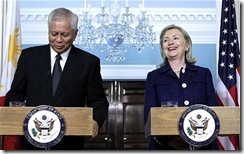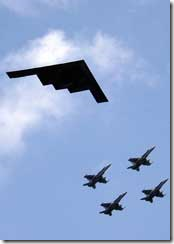This is a collection of articles, essays, and blogs (or web logs) that relate to the issues and controversies surrounding the East China Sea (the Senkaku Islands or Diaoyutai Islands (Diaoyutai Qundao)), and South China Sea (the Spratly Islands).
M. Ulric Killion writes,Photo Source: “The Philippines’ largest warship is in a stand-off with Chinese vessels in the South China Sea”, Reuters; See Philippines ‘withdraws warship’ amid China stand-off, BBC news, April 12, 2012.The maritime dispute in the China South Sea, according to recent news source, such as BBC news, between the competing interests of China and the Philippines recently almost broached the peace between these two nations. . . .This is because what is at stake, as mentioned in an earlier writing, “the right of sovereignty symbolizes the right of access to much-needed natural resources, which includes the prize of access to potential oil and natural gas supplies. More accurately, these natural resources include fish, guano, and undermined oil and natural gas potentials.”A problem for the international community is that the territorial disputes arising in the South China Sea are international in dimension, involve issues of international law (i.e., govern by the International Law of Sea), and affects many nations, including nations, such as the United States, which do not have a sovereign interest in the South China Sea.It is especially for this reason. . . .

BBC news reports,Asean members also discussed proposals to draft a code of conduct to resolve territorial disagreements in the South China Sea.
The region is rich in resources, and encompasses shipping routes important to traders across the world.
However, China has competing claims to several territories with Brunei, Malaysia, Vietnam and the Philippines. . . .

Raymond Burghardt, Geopolitical Monitor, writes,For those of us who served in Vietnam during the war years, this celebration was the latest reminder of the remarkable transformation of a relationship from one of bitter foes to strategic partners. Ties between the United States and Vietnam have steadily improved since they were formally normalized in 1995, but the pace has accelerated during the past three years, motivated in part by shared concern over China’s aggressive maritime claims in the South China Sea. . . .

Andrew Jacobs writes,Photo: A Military Alliance on Full Display: Thousands of American and Filipino marines carry out military exercises in the Philippines.The rhetorical missiles fired by a state-owned Chinese newspaper late last month landed squarely on the shores of this westernmost province and a few dozen kilometers from the coral reefs and scrub-covered islets claimed by China, the Philippines and a number of other nations.“If these countries don’t want to change their ways with China, they will need to prepare for the sound of cannons,” wrote the unapologetically nationalistic Global Times, referring to the 750 islands and spits of land in the South China Sea, known as the Spratly Islands, which are also contested by Brunei, Malaysia, Taiwan and Vietnam. . . .

M. Ulric Killion writes,Photo: Secretary of State Hillary Rodham Clinton and Philippines' Foreign Minister Albert del Rosario meet with reporters at the State Department in Washington Photo: AP. According to U.S. Secretary of State Hillary Rodham Clinton, “We are concerned that recent incidents in the South China Sea could undermine peace and stability” (US ready to arm Philippines against rise of China, The Telegraph, June 23, 2011).The dispute concerning issues of sovereignty over the South China Sea has a long history, notwithstanding the dispute over the East China Sea – the Senkaku Islands or Diaoyutai Islands (Diaoyutai Qundao). The Spratly Islands comprise about forty-five (45) islands. These islands are also occupied by military units from Vietnam, China, Taiwan, and the Philippines. There is even occupancy, though not a military occupancy, of an island by Brunei, which claims an exclusive economic zone (EEZ) (i.e., the Law of the Sea) in the southeastern part of the Spratly Islands. . . .

Thomas P.M. Barnett, World Security Institute, writes,Amidst “rising” China’s increasingly frequent displays of militaristic bravado in East Asia, America has upped the ante with the introduction a new war doctrine aimed at the Pacific. The AirSea Battle Concept (ASBC), in its basic form, is a call for cooperation between the Air Force and Navy to overcome anti-access and area denial (A2/AD) capabilities of potential enemies. At first glance, that seems like an innocuous and even practical idea. When implemented, however, the ASBC will be a jab at China’s most sensitive pressure points. Given China’s rising encirclement paranoia—most recently fueled by US arms sales to Taiwan, intrusion into the Spratly Islands dispute and naval exercises with the South Koreans in the Yellow Sea—Beijing will likely not take news of this development well. As a long-term strategy, the upshot may be an escalation of hostilities that will lock the United States into an unwarranted Cold War-style arms competition. . . .

Sam LaGrone, Jane’s Defence News, writes,Photo: A model of a possible future aircraft carrier appeared alongside other new PLA weaponry in a military exhibition in Hong Kong on July 4th, stoking the enthusiasm of Chinese military fans. (The CN Carrier website describes its mission as "giving the construction of a Chinese aircraft carrier a shot of nationalistic steroids.") According to a report appearing in today’s Chongqing Times, the look of the model resembles the Soviet aircraft carrier Varyag, which was to be the second Admiral Kuznetsov class carrier before construction was halted and the ship was sold to China, stripped of much of its propulsion system. Chongqing Times (viaDanwei.org), July 6, 2009.China has stated publicly for the first time its intention to acquire two or more indigenously designed and built aircraft carriers for the People’s Liberation Army Navy (PLAN).A brief reference to the strategy has appeared in an annual report from the the State Oceanic Administration (SOA). Although it was published in May, the reference was buried at the end of the 570-page document and has only now been picked up by news outlets in the Asia-Pacific region. . . .

Photo: China’s claim on the South China Sea.It’s summertime, and the world’s navies have been cruising each other in the warm waters of the world’s oceans as if it were some kind of brawny maritime love parade. Indeed, there has been a flurry of naval action in the Asian theatre recently – some of it routine and annual, some related to the Cheonan incident, but also chest thumping and jostling for position in territorial claims all over the place. . . .
Daniel Dzurek writes,The rekindled sovereignty dispute between Japan and China (includingTaiwan) over the Senkaku/Diaoyu Islands [1] at the eastern edge of the East China Sea involves 500-year-old claims and future offshore oil development. Sovereignty over the islets could affect 40,000 sq km of surrounding continental shelf/EEZ area. The most recent flare-up was ignited when a Japanese ultranationalist group built a makeshift lighthouse on one of the islets, which are controlled by Japan. Diplomatic notes, popular demonstrations, convoys of protest boats, and the death of one protester, who drowned near the islands, have inflamed passions, but done little to shed light on the sovereignty and jurisdictional issues. . . .
